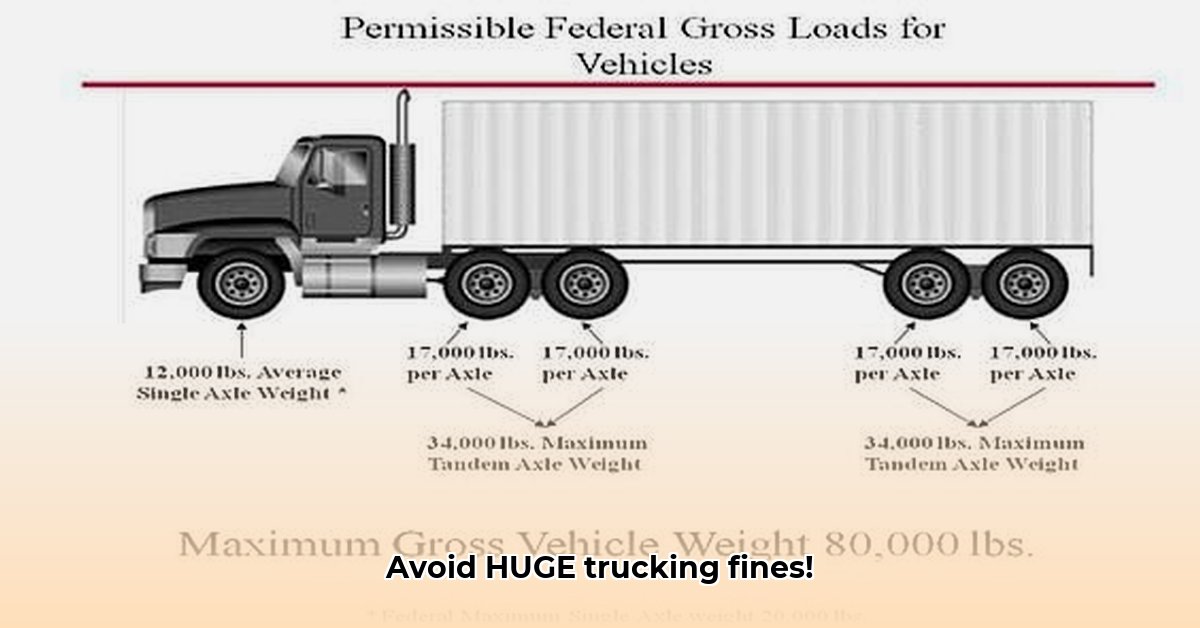
Understanding the Basics: More Than Just the Gross Vehicle Weight
Staying within legal weight limits is crucial for safety, avoiding hefty fines, and maintaining a profitable trucking business. While the federal government sets a maximum gross vehicle weight (GVW) of 80,000 pounds for most tractor-trailers, this is just the beginning. Axle weight limits are equally critical. A single axle typically can't exceed 20,000 pounds, and a tandem axle set (two axles close together) is usually capped at 34,000 pounds. However, these limits vary significantly by state, creating a complex regulatory landscape. Exceeding even one axle weight limit can result in substantial fines, even if your overall GVW is within the legal range. For more on truck weight, see tractor trailer weight.
Did you know that uneven weight distribution is a leading cause of overweight violations? Even if your total weight is legal, overloaded axles lead to fines. Careful cargo placement is key to achieving proper balance.
Mastering Weight Distribution: The Key to Legal Compliance
Uneven weight distribution is a common cause of overweight violations. Even with a legal GVW, overloaded axles result in fines. Strategic cargo placement is essential. Consider the weight of each item and its position within the trailer. Small adjustments in cargo placement can significantly impact weight distribution. Repositioning the fifth wheel (the connection between tractor and trailer) might also help.
Quantifiable Fact: Studies show that improper weight distribution accounts for up to 60% of overweight violations.
Practical Steps for Legal Weight Management
Here's a step-by-step guide to ensure legal and efficient weight management:
Know Your Route's Limits: Thoroughly research federal and state regulations for your entire route. State laws vary considerably, making pre-trip planning essential. Consult state DOT websites for the most up-to-date information.
Regular Weighing is Crucial: Use certified weigh stations (like CAT scales) before and during trips. Don't rely on estimations. Regular weighing also helps detect subtle weight shifts indicating potential mechanical issues.
Master the Art of Loading: Plan cargo placement carefully to distribute weight evenly across all axles. This involves knowing the weight of each item and strategically positioning heavier and lighter items. Experimentation is vital to finding optimal load configurations.
Leverage Technology: Weight management software streamlines weight calculations, optimizes routes based on weight limits, and assists with load planning. This technology is particularly beneficial for larger fleets.
Prioritize Maintenance: Ensure your truck's suspension and braking systems are in top condition. Poorly maintained components can affect weight distribution and increase accident risk.
Invest in Driver Training: Thoroughly train your drivers on proper weight management techniques, including understanding regulations, using technology, and recognizing signs of uneven weight distribution.
Expert Quote: "Proactive weight management isn't just about avoiding fines; it's about ensuring driver safety and protecting your business," says Dr. Emily Carter, Transportation Safety Expert at the National Transportation Safety Board.
Navigating State-Specific Regulations
State regulations add significant complexity. Weight limits and rules vary significantly, and some even introduce seasonal restrictions (often called "Frost Laws") to protect roads during thawing. Thoroughly research the specific regulations for each state you'll be traversing before your journey.
The High Cost of Non-Compliance
Ignoring legal weight limits leads to hefty fines, legal battles, increased accident risk, and potential damage to your business's reputation. These costs vastly outweigh the investment in proper weight management.
Proactive Strategies: A Summary
The following table summarizes proactive strategies for legal weight management:
| Strategy | Pros | Cons |
|---|---|---|
| Weight Management Software | Automates calculations, optimizes routes, improves efficiency. | Initial investment, requires training. |
| Driver Training | Improves driver awareness, reduces violations, promotes safety culture. | Requires time and resources. |
| Regular Weighing | Ensures compliance, helps identify potential issues early. | Adds time to the trip. |
| Consulting with Experts | Provides personalized advice, helps navigate complex regulations. | Can be costly. |
Key Takeaways: Prioritize Safety and Compliance
Mastering legal weight management is essential for responsible trucking. Prioritize safety, invest in technology and training, and stay informed about ever-evolving regulations to mitigate risks and maintain a profitable and legally compliant operation. Remember, it's about more than just avoiding fines; it's about operating safely and responsibly on our nation's highways.